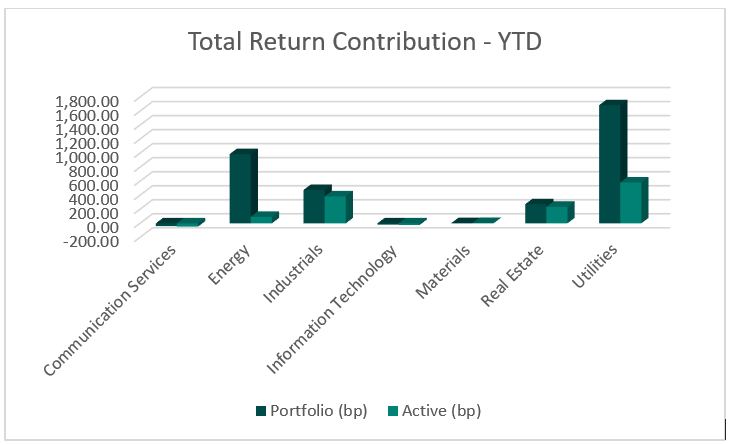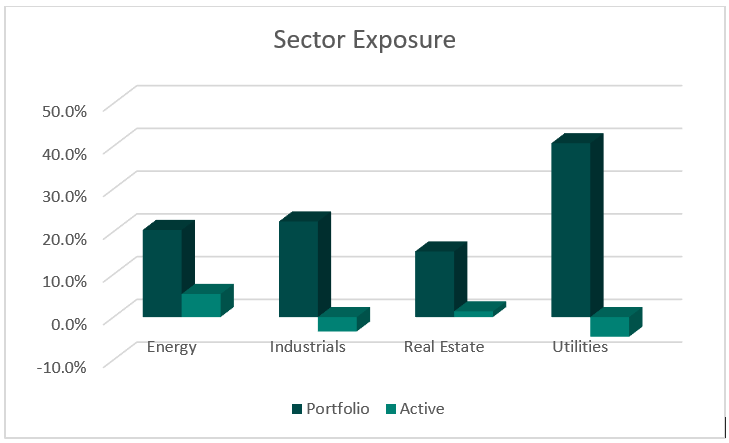Monthly Update
Year-to-date to November 30, the Ninepoint Global Infrastructure Fund generated a total return of 31.75% compared to the MSCI World Core Infrastructure Index, which generated a total return of 20.46%. For the month, the Fund generated a total return of 6.25% while the Index generated a total return of 3.99%.
Ninepoint Global Infrastructure Fund - Compounded Returns¹ As of November 30, 2024 (Series F NPP356) | Inception Date: September 1, 2011
1M |
YTD |
3M |
6M |
1YR |
3YR |
5YR |
10YR |
Inception |
|
|---|---|---|---|---|---|---|---|---|---|
Fund |
6.3% |
31.8% |
13.8% |
18.4% |
31.7% |
12.9% |
10.6% |
8.0% |
8.8% |
MSCI World Core Infrastructure NR (CAD) |
4.0% |
20.5% |
7.2% |
15.7% |
21.3% |
8.5% |
6.7% |
8.5% |
11.2% |
As we approach the holiday season and the end of 2024, investors should be pleased with their returns for the year. Further, although we are already part way through December, we are entering what has historically been a seasonally strong period for the equity markets, especially after excellent year-to-date performance. We think that the themes and trends that have been working are likely to persist through the balance of the year and into early 2025, as investors chase performance while refraining from selling winners to avoid realizing taxable capital gains.
The first week of November has really set the stage for this outcome, with two key catalysts occurring over the span of just three days. The most important catalyst was obviously the US Presidential Election on November 5th, and the Trump victory coupled with the Republican Party’s sweep of Congress was well received by the equity markets. The investment themes that subsequently outperformed were the same as the ones that had worked after the 2016 election and were tied to deregulation, lower taxes and economic growth. Conversely, stocks exposed to the threat of tariffs on foreign-produced goods and almost every stock related to renewable energy production dramatically underperformed.
The second key catalyst, the US FOMC meeting on November 7th, was almost lost in the election noise but the Committee did announce its second rate cut of the cycle, lowering the overnight rate by 25 basis points to 4.75%. However, the odds of another 25-bps cut in December have subsequently fallen and the number of expected interest rate cuts in 2025 have declined from four to just two, as the economy has remained robust, and the labour market has remained firm. The rationale for fewer interest rate cuts going forward is also based on the fact that President Trump’s policies (primarily aggressive fiscal spending and tariffs on foreign-produced goods) are considered broadly inflationary, but we would like to take a wait-and-see approach before making judgement because some of the President-elect’s other policies may prove deflationary (further, it remains to be seen what will ultimately be enacted). In the meantime, the prospect of generally lower interest rates remains supportive for the equity markets through the easing cycle as long as the economic data does not deteriorate significantly from here.
Into 2025, we are optimistic for continued positive equity performance, but we think that there is the potential for a brief period of weakness at the beginning of the year. Conceptually, portfolio rebalancing after year end may create some weakness at the index level, as investors rotate out of the largest mega cap growth companies into the more undervalued, cyclical parts of the market. We think that the growth rate differential between the Mag7 and the rest of the market should converge more significantly in 2025, which would provide some support for this trade. But broadly speaking, with S&P 500 consensus earnings estimates rising through 2024 and currently at $280 for 2025 and $305 for 2026 (according to LSGE), we still think equity markets will post solid gains in 2025.
Top contributors to the year-to-date performance of the Ninepoint Global Infrastructure Fund by sector included Utilities (+1,684bps), Energy (+987 bps) and Industrials (+476 bps), while top detractors by sector included Communication Services (-39 bps) and Information Technology (-19 bps) on an absolute basis.
On a relative basis, positive return contributions from the Utilities (+582 bps), Industrials (+385 bps) and Real Estate (+237 bps) sectors were offset by negative contributions from the Communication Services (-47 bps) and Information Technology (-22 bps) sectors.

We are currently slightly overweight the Energy and Real Estate sectors and slightly underweight the Utilities and Industrials sectors. With the US Presidential Election behind us and monetary policy easing underway, we are optimistic over the balance of the year and into 2025. However, we will be carefully watching for policy announcements from the incoming President’s administration and the ensuing impact on growth and inflation. The key question for the equity markets in 2025 will be whether President Trump’s policies prove inflationary, thus creating a spike in bond yields and necessitating a pause in the monetary policy easing cycle.
If we do see a spike in inflation and interest rates, we plan to actively manage our exposure by reducing interest rate-sensitive sectors (Real Estate and Utilities) and adding more GDP/inflation-sensitive sectors (Energy and Industrials). In the meantime, we remain focused on high quality, dividend paying infrastructure assets that have demonstrated the ability to consistently generate revenue and earnings growth through the business cycle.
Finally, despite the new administration in Washington, we continue to believe that the infrastructure asset class is ideally positioned to benefit from two significant investment themes for many years ahead: the Electrification of the US Economy and the Energy Transition. Importantly, electricity demand is expected to accelerate dramatically, led by the construction of AI-focused data centers, the onshoring of industrial manufacturing and the continued growth of electrified transportation, industries that are largely supported by President Trump’s stated policies. Therefore, we are comfortable having exposure to various infrastructure sub-sectors or sub-industries, including traditional energy investments, clean energy investments and electrical, natural gas, nuclear or multi-utilities in the Ninepoint Global Infrastructure Fund to take advantage of related investment opportunities.

The Ninepoint Global Infrastructure Fund was concentrated in 30 positions as at November 30, 2024 with the top 10 holdings accounting for approximately 37.3% of the fund. Over the prior fiscal year, 23 out of our 30 holdings have announced a dividend increase, with an average hike of 13.2% (median hike of 4.7%). Using a total infrastructure approach, we will continue to apply a disciplined investment process, balancing valuation, growth, and yield in an effort to generate solid risk-adjusted returns.
Jeffrey Sayer, CFA
Ninepoint Partners

 November 30, 2024
November 30, 2024



